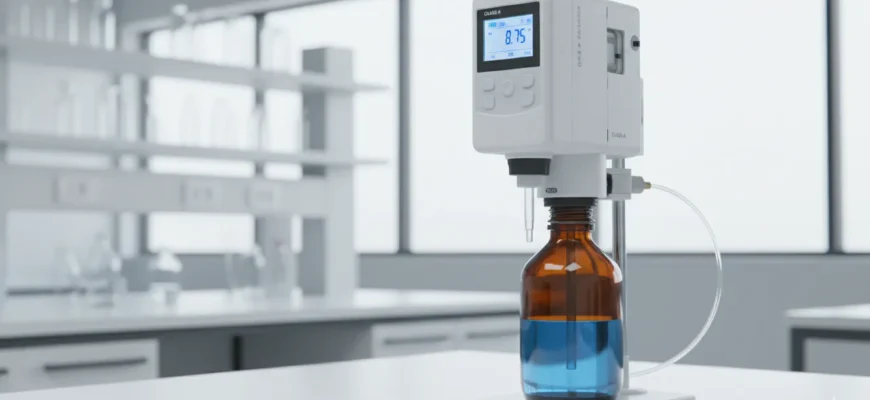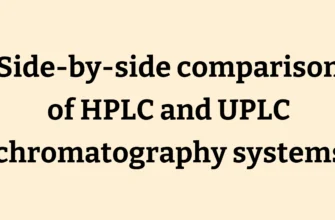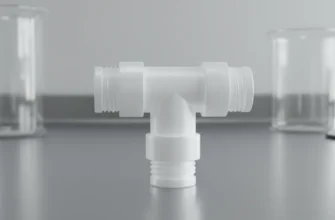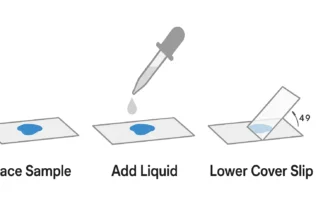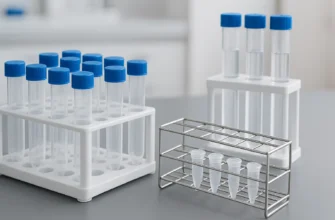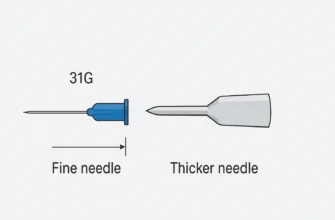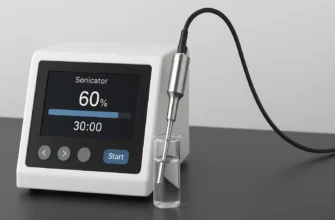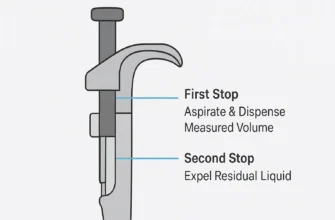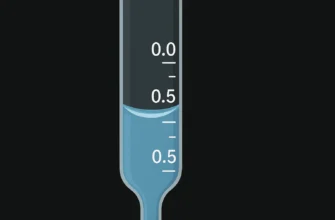How a Digital Burette Enhances Liquid Handling Efficiency
Key Highlights
A digital burette is a modern piece of laboratory equipment that significantly improves liquid handling efficiency. It provides highly accurate measurements with Class A precision, reducing the human error associated with traditional glass burettes. Digital burettes meet Class A error limits according to DIN EN ISO 385 standards, offering precision of up to three decimal places for volumes below 20 mL.
Key advantages include:
-
Exceptional accuracy: Digital burettes achieve tolerances as low as ±0.02-0.05 mL for Class A compliance
-
Seamless workflow integration through intuitive controls and automated dispensing options
-
Superior chemical resistance with wetted parts made from materials like borosilicate glass, ETFE, PFA, FEP, PTFE, and platinum-iridium
-
Enhanced safety through closed-system design reducing chemical exposure
-
Cost-effective operation with reduced reagent waste and improved reproducibility
Introduction
In analytical laboratories, precision is paramount for reliable results. Traditional glass burettes, while functional, present several limitations including fragility, cleaning difficulties, and susceptibility to human error through parallax readings and inconsistent flow control. Digital burettes represent a transformative advancement in liquid handling technology, offering superior accuracy, enhanced safety, and streamlined operations that can dramatically improve laboratory productivity and data quality.
Understanding Digital Burettes in Modern Laboratories
A digital burette is an advanced liquid dispensing instrument that mounts directly onto reagent bottles using threaded adapters (typically GL 45 standard). The system employs a telescoping intake tube to draw liquid directly from the bottle, eliminating the need for constant refilling—a significant advantage over traditional glass burettes.
Core Components and Operation:
The digital burette features an electronic control panel with a clear LCD display that shows dispensed volumes in real-time. Instead of relying on manual readings of etched graduations, users can program exact volumes with digital precision. The system uses a precision piston mechanism controlled either manually through hand wheels or via motorized operation for fully automated dispensing.
Advanced Piston Technology: Modern digital burettes employ high-precision pistons made from chemically resistant materials such as PTFE (polytetrafluoroethylene). This piston-based dispensing system ensures consistent, controlled liquid delivery with minimal dead volume.
Comparing Electronic Burette and Traditional Glass Burette
The transition from traditional glass burettes to electronic models represents a significant advancement in laboratory efficiency and safety. Here’s a comprehensive comparison:
| Feature | Digital Burette | Traditional Glass Burette |
|---|---|---|
| Accuracy | High precision with Class A compliance (±0.02-0.05 mL) | Dependent on manual reading, prone to parallax error (±0.05-0.10 mL) |
| Durability | Robust construction with chemical-resistant materials | Fragile borosilicate glass susceptible to breakage |
| Efficiency | Fast, programmable dispensing with automated features | Slow manual control requiring constant attention |
| Safety | Closed system reduces chemical exposure and spills | Open system increases exposure risk |
| Maintenance | Easy cleaning with automated purging systems | Time-consuming manual cleaning protocols |
| Cost | Higher initial investment ($400-1000+) | Lower upfront cost but higher long-term operational costs |
Key Features of Digital Titration Burette Systems
Modern digital burettes incorporate sophisticated features designed to enhance accuracy, efficiency, and user convenience:
Essential Display and Control Features:
-
Clear Digital Display: High-resolution LCD screens provide real-time volume information, eliminating meniscus reading uncertainties
-
Intuitive Controls: User-friendly interfaces with push-buttons or touchscreen operation for precise volume setting
-
Multiple Dispensing Modes: Options for continuous, drop-wise, or pre-programmed volume dispensing
Advanced Technical Features:
-
Motor-Driven Operation: Fully automated dispensing with calibrated pre-set speeds including precise drop-wise control at 0.010 mL/sec
-
Valveless Dosing System: Advanced designs minimize dead volume and enhance reproducibility
-
Recirculation Systems: Prevent reagent waste during priming and system purging
-
Data Logging Capabilities: RS-485 or RS-232 interfaces for PC connectivity and GLP compliance documentation
Safety and Convenience Features:
-
Safety Discharge Systems: Reduce risk of accidental dispensing and splashes
-
Telescopic Filling Tubes: Adjustable intake tubes accommodate different bottle heights
-
Temperature Compensation: Built-in calibration adjustments for different liquid densities and temperatures
Main Advantages of a Digital Burette for Liquid Handling Efficiency
Digital burettes offer compelling advantages that directly enhance laboratory operations and analytical quality.
Improved Accuracy and Precision in Dispensing Liquids
Class A Precision Standards: Digital burettes achieve Class A accuracy specifications according to DIN EN ISO 385 standards. High-quality models provide accuracy within ±0.02-0.05 mL tolerances, with some offering precision to three decimal places for volumes below 20 mL.
Measurement Range and Resolution: Modern digital burettes offer impressive dispensing ranges from as little as 1 microliter (μL) to 50 milliliters (mL) or more. The minimum resolution can be as fine as 10 μL, providing exceptional control for precise analytical work.
Controlled Dispensing Mechanism: Unlike manual methods where results vary based on operator technique, digital burettes use controlled piston movement to dispense liquid with exceptional consistency. This eliminates variables such as hand tremor, inconsistent pressure application, and timing variations that affect traditional burette accuracy.
Elimination of Reading Errors: Digital displays eliminate parallax errors and the subjective interpretation of meniscus positions that commonly occur with glass graduations. Real-time digital readouts provide immediate, unambiguous volume information.
Enhanced User Convenience and Workflow Integration
Direct Bottle Mounting: Digital burettes attach directly to reagent bottles using standard GL 45 threads and adapters, eliminating time-consuming refilling procedures. This direct connection significantly reduces setup time and reagent handling.
Automated Operation Features:
-
Programmable Dispensing: Motor-driven models can be programmed for specific volumes and dispensing speeds, reducing operator fatigue and increasing throughput
-
Quick Purging Systems: Automated purging modes quickly remove air bubbles and prepare the system for use
-
Multiple Speed Settings: Pre-calibrated dispensing speeds from rapid filling to precise drop-wise titration
Data Management and Compliance: Advanced models feature PC interfaces enabling direct data transfer for GLP/ISO compliance documentation. This integration streamlines record-keeping and supports regulatory requirements in pharmaceutical and analytical laboratories.
Safety Enhancements: The closed-system design minimizes operator exposure to hazardous chemicals. Safety discharge systems and leak-proof connections reduce the risk of spills and contamination.
Choosing the Right Digital Burette for Your Lab
Selecting an appropriate digital burette requires careful consideration of laboratory requirements, budget constraints, and long-term operational needs.
Essential Criteria and Features to Consider
Accuracy and Volume Requirements:
-
Class A Compliance: Ensure the burette meets DIN EN ISO 385 Class A standards for analytical applications
-
Volume Range: Select appropriate capacity (typically 10 mL, 25 mL, or 50 mL) based on titration requirements
-
Resolution: Consider minimum dispensing increments—high-precision applications may require 1 μL resolution
Operating Mechanism:
-
Manual vs. Motorized: Hand-driven models offer cost-effectiveness for basic applications, while motor-driven units provide automation and programmability
-
Control Interface: Evaluate display quality, button layout, and programming ease
-
Speed Control: Multiple pre-set dispensing speeds enhance versatility
Advanced Features for Professional Applications:
-
Data Connectivity: RS-485/RS-232 interfaces for computerized data logging and GLP compliance
-
Calibration Capabilities: User-adjustable calibration for different liquid densities
-
Memory Functions: Storage of frequently used dispensing volumes
Cost Considerations: Digital burettes range from approximately $400-1000+ depending on features and specifications. Consider total cost of ownership including calibration requirements, consumables, and maintenance.
Compatibility with Various Titrants and Bottle Types
Chemical Resistance: High-quality digital burettes feature wetted parts manufactured from highly corrosion-resistant materials including:
-
Borosilicate Glass 3.3: Primary construction material for chemical stability
-
Fluoropolymers: ETFE, PFA, FEP, and PTFE for exceptional chemical compatibility
-
Ceramic Components: Aluminum oxide (Al₂O₃) and platinum-iridium for ultimate resistance
Bottle Compatibility: Digital burettes accommodate various container types through included adapter sets:
-
Standard Threads: GL 32, GL 38, GL 45, and S 40 connections
-
Adjustable Intake Systems: Telescopic tubes accommodate bottle heights from 200-350 mm
-
Universal Design: Single instrument can be moved between different reagent bottles
Application Limitations: While digital burettes offer broad chemical compatibility, certain restrictions apply:
-
Crystallizing Media: May cause piston jamming and require intensive cleaning
-
Aggressive Acids: Hydrofluoric acid attacks borosilicate glass; concentrated HCl (>40%) and HNO₃ (>70%) may cause issues
-
Specific Solvents: Some organic solvents like tetrahydrofuran may not be compatible
Calibration and Maintenance
Calibration Procedures
Standard Calibration Protocol: Digital burette calibration follows gravimetric methods using distilled water at 20°C. The procedure involves:
-
Temperature Verification: Confirm water temperature for density calculations
-
Volume Dispensing: Dispense specific volumes (typically 10 mL increments) into pre-weighed containers
-
Mass Measurement: Weigh dispensed volumes using analytical balances accurate to 0.1 mg
-
Correction Calculation: Compare actual vs. indicated volumes to determine correction factors
Calibration Frequency: Industry standards recommend calibration every 3-6 months, with minimum testing of two volumes (nominal and lowest settings) using 10 replicate measurements. High-precision applications may require more frequent calibration.
Maintenance Procedures
Standard Cleaning Protocol:
-
Initial Rinse: Flush system with distilled water using recirculation mode
-
Complete Filling: Fill and empty the burette several times
-
Chemical Cleaning: Use appropriate cleaning agents for specific contaminants
-
Final Rinse: Multiple rinses with deionized water
Intensive Maintenance: For crystallizing media or contaminated systems, disassembly may be required following manufacturer protocols. Key components including pistons, cylinders, and valve assemblies can be individually cleaned or replaced.
Proper Storage: Store digital burettes in clean, dry environments at temperatures between -20°C to +50°C with relative humidity 5-95%. Maintain upright position as recommended by manufacturers.
Safety Considerations
Personal Protective Equipment: Always use appropriate PPE when operating digital burettes:
-
Eye Protection: Safety glasses or goggles, with face shields for splash-prone applications
-
Hand Protection: Chemical-resistant gloves appropriate for specific reagents
-
Respiratory Protection: May be required for volatile or hazardous substances
Operational Safety:
-
Static Charge Prevention: Avoid dispensing flammable liquids into plastic containers
-
Ventilation Requirements: Ensure adequate fume hood operation for volatile reagents
-
Emergency Procedures: Establish protocols for spills, equipment malfunction, and chemical exposure
Conclusion
Digital burettes represent a significant advancement in liquid handling technology, offering remarkable improvements in accuracy, efficiency, and safety compared to traditional glass alternatives. With Class A precision capabilities, automated dispensing features, and superior chemical compatibility, these instruments enhance laboratory productivity while ensuring consistent, reliable results.
The key benefits include elimination of human error through digital displays and controlled dispensing, streamlined workflows through direct bottle mounting and automated features, and enhanced safety through closed-system designs. While initial investment costs are higher than traditional burettes, the long-term advantages of improved efficiency, reduced reagent waste, and enhanced data quality provide compelling value for modern analytical laboratories.
When selecting a digital burette, laboratories should prioritize Class A compliance, appropriate volume ranges, chemical compatibility with intended applications, and features that support their specific analytical requirements. With proper calibration, maintenance, and safety protocols, digital burettes provide a robust foundation for precise analytical work across pharmaceutical, environmental, food, and research applications.
The future of liquid handling continues to evolve toward greater automation, connectivity, and precision. Digital burettes exemplify this evolution, transforming traditional titration practices into efficient, accurate, and safe analytical procedures that meet the demanding requirements of contemporary laboratory science.
Frequently Asked Questions
What is the typical accuracy range of digital burettes?
Digital burettes meeting Class A specifications achieve tolerances of ±0.02-0.05 mL depending on volume capacity. High-quality models provide measurement ranges from 1 microliter to 50 milliliters with resolutions as fine as 10 μL. The BrandTech Titrette, for example, meets Class A accuracy specifications and offers precision to three decimal places for volumes below 20 mL.
How do you calibrate a digital burette for reliable use?
Calibration follows gravimetric procedures using distilled water at reference temperature (20°C). The process involves dispensing known volumes into pre-weighed containers on analytical balances, comparing actual delivered mass to programmed volume, and adjusting the instrument according to manufacturer specifications. Industry standards recommend calibration every 3-6 months with testing at multiple volume points using 10 replicate measurements.
What maintenance steps are needed to extend the life of a digital burette?
Regular maintenance includes standard cleaning after each use by flushing with distilled water, followed by rinsing with the next reagent to be used. For intensive cleaning, systems can be disassembled for component-level cleaning or replacement. Proper storage in clean, dry environments at appropriate temperatures (typically -20°C to +50°C) with the instrument in upright position helps preserve component integrity. Regular inspection of seals, pistons, and electronic components ensures optimal performance.

